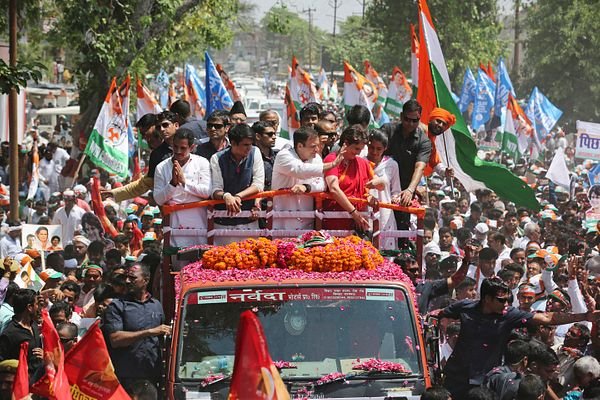Why in the News?
- A recent investigation found that over 22% of India’s roughly 5,300 legislators have familial links to current or former lawmakers.
- The persistence of dynastic politics across parties (national and regional) raises questions about winnability, party culture and democratic renewal.
- The report prompts debate on whether legal or institutional reforms can curb family-based control of political power.
Key Highlights
- From monarchy to democratic republic — an unfinished social change
- In 1950, India adopted the Constitution and formally ended monarchic titles and princely states.
- Former royals and elites did not disappear; many transitioned into electoral politics and used their social standing to win democratic offices.
- Thus, a formal end to monarchy did not end family-based political influence.
- Early post-Independence politics and the Congress model
- The Congress dominated the first three national elections, drawing leaders from the freedom movement.
- As leadership concentrated, the party’s top posts and government offices became linked, creating space for family succession (notably the Nehru–Gandhi family).
- Over decades, party organisation weakened and personal networks replaced mass-based structures, enabling dynastic continuity.
- Regional satraps and the spread of family-based parties (1970s–1990s)
- During this time, many strong regional leaders like Biju Patnaik, Mulayam Singh Yadav, and Lalu Prasad Yadav became powerful in their states.
- These leaders started their own political parties, often controlled by their families.
- Over time, their parties turned into family-run organisations, where leadership passed from one generation to the next.
- This made people accept the idea that politics can run like a family business, where the family name itself becomes a political brand.
| “Regional Satraps” means dominant regional political bosses who consolidated their power and helped spread family-based (dynastic) politics across India during the 1970s–1990s. |
- Dynasties across the spectrum — adaptation and absorption
- Parties that once criticised dynasties (e.g., non-Congress groups) later adopted similar family practices when politically convenient.
- Even ideology-driven parties have second-generation entrants from political families.
- The dominant logic became winnability: parties prefer candidates with local networks and resources, often supplied by political families.
- Structural drivers: money, networks and institutional gaps
- Modern elections are expensive, favouring those with access to money and organisational manpower.
- Families often control businesses, institutions and patronage networks, giving their members a distinct advantage.
- The Representation of the People Act and party autonomy leave no legal barrier to dynastic selection, embedding the practice into ordinary politics.
| 1. Dynastic Politics a. Dynastic politics refers to the recurrence of political office within families across generations. b. It often arises from the inheritance of social capital, name recognition and local networks. c. Dynasties are common in many democracies, but their prevalence varies with institutional contexts. d. They can both stabilise party fortunes locally and hinder leadership renewal. e. Research links dynastic advantage to easier access to resources, media coverage and patronage networks. f. Studying dynasties helps analyse elite reproduction and obstacles to inclusive political representation. 2. Political Patronage a. Political patronage is the distribution of benefits (jobs, services, contracts) in exchange for political support. b. Families with entrenched power often control patronage networks at local levels. c. Patronage consolidates loyalty and creates informal political hierarchies. d. Reducing patronage requires transparent public services and strong institutions. e. Patronage dynamics explain why incumbency and family ties often yield electoral advantages. 3. Representation of People Act a. The Representation of the People Act (RPA) is the primary statute governing elections, candidate eligibility and election offences. b. The Act focuses on electoral procedure, corrupt practices and conduct of polls rather than internal party governance. c. Because RPA does not regulate candidate selection within parties, it does not directly prevent dynastic nominations. |
Implications
- Concentration of power: Dynasties concentrate political power in a few families, narrowing democratic competition.
- Merit and motivation: Preferential selection of relatives can demotivate party workers and limit merit-based leadership emergence.
- Policy capture risk: Families that control politics for long periods can shape policy to favour entrenched interests.
- Social mobility and representation: Dynastic dominance may block fresh voices, including youth and marginalized groups, from political office.
- Electoral calculus persists: Until elections become cheaper and parties reform candidate selection, dynasties will remain electorally useful and thus resilient.
Challenges and Way Forward
| Challenge | Way Forward |
| High cost of electoral competition | Enforce campaign-finance reforms, state funding for parties, and stricter transparency for donations to level the playing field. |
| Party autonomy in candidate selection | Encourage internal party democracy via legal incentives (e.g., disclosure of selection processes) and primaries/polls within parties. |
| Concentration of local networks and patronage | Strengthen local self-government and civic institutions so public services are less dependent on individual patronage. |
| Lack of legal restrictions on dynastic succession | Consider disclosure norms for party candidates, term-limit debates for key party offices, and greater internal accountability rules. |
| Weak grassroots leadership pipeline | Invest in youth political training, party cadre development, and affirmative measures for underrepresented social groups in nominations. |
Conclusion
Dynastic politics in India is rooted in historical legacies, electoral incentives and institutional gaps. Family networks remain powerful because they offer resources, recognition and organisational reach — all valuable in a high-cost electoral system. Reducing dynastic dominance will require systemic reforms: campaign finance regulation, stronger internal party democracy, local institution-building and active measures to nurture new leaders. Without changing incentives, family politics will continue to reproduce itself.
| EnsureIAS Mains Question Q. Examine the causes of dynastic politics in India and assess institutional reforms that could broaden political participation and reduce family-based control of elective offices. (250 Words) |
| EnsureIAS Prelims Question Q. Consider the following statements: 1. Over 20% of India’s legislators have familial ties with current or former legislators, according to recent reports. 2. The Indian Constitution contains explicit provisions that prohibit dynastic politics and family succession in political parties. 3. The Representation of the People Act currently lacks specific provisions to restrict dynastic control within political parties. Which of the following statements are correct? Answer: c) 1 and 3 only Explanation: Statement 1 is correct: Recent journalistic investigations show that about 22% of India’s MPs, MLAs and MLCs have family links to current or former legislators, indicating widespread dynastic presence. Statement 2 is incorrect: The Constitution does not explicitly ban dynastic politics. It guarantees equality and democratic governance, but it does not regulate internal party succession or family-based nominations. Political party autonomy leaves scope for familial influence. Statement 3 is correct: The Representation of the People Act governs elections but does not include specific clauses to prevent family dominance in parties. As parties enjoy autonomy, the Act does not directly curb dynastic nominations, making legal change or internal party reform necessary. |
Also Read | |
| UPSC Foundation Course | UPSC Daily Current Affairs |
| UPSC Monthly Magazine | CSAT Foundation Course |
| Free MCQs for UPSC Prelims | UPSC Test Series |
| Best IAS Coaching in Delhi | Our Booklist |




